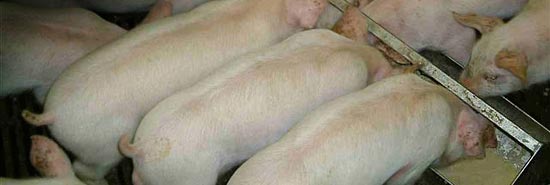• reduce feed costsTraditionally, liquid feeding systems developed in areas where liquid co-products from the human food industry were abundant and cheap. Industries involved in potato, vegetable, milk and fish processing, starch and sugar manufacture, baking, brewing and bio-ethanol production all generate co-products that can be valuable and cost-saving inclusions in liquid diets. Many of these materials are acidified at source to prevent spoilage. Inclusion of these acidified components in liquid feeds has been shown to reduce significantly the incidence of Salmonella and other enteropathogens in pigs.
• reduce nitrogen and phosphate levels in pig manure
• replace antimicrobial growth promoters
• reduce the incidence of salmonella in pig meat

Producers who do not have access to co-products can also gain similar advantages by using fermented liquid cereals in diets. If cereals are mixed with water and left of 24 h almost all the phytate bound phosphorus is released. This means that the amount of phosphate that needs to be added to the diet can be reduced and subsequently the phosphate content of manure will be reduced. When cereals are soaked, naturally occurring lactic acid bacteria (LAB) create a spontaneous fermentation. In ideal circumstances, the fermentation generates significant quantities of lactic acid, which eliminates enteropathogens like Salmonella, E. coli and Lawsonia from the diet and can reduce the incidence of health problems caused by these organisms in the pig. Thus FLF can be seen as at least a partial replacement for antibiotic growth promoters. Our studies have shown that there are also considerable benefits from giving lactating sows FLF. Sows fed FLF had increased concentrations of immunoglobulin in their milk. There were also beneficial effects on the development of the immune system and gut flora of their piglets.
Having gained a lot of experience on commercial units, we consider the results from spontaneous fermentation of complete diets are much too unpredictable for us to recommend this approach to producers. However, predictable results can be achieved by producing Inoculated Fermented Liquid Feed (IFLF). This is produced by the controlled fermentation of the energy supplying portion of the diet (the cereals or starch based co-products). The temperature of the liquid cereal must be controlled (between 20 & 30°C) and it must be inoculated with specially selected LAB that can produce 150-250 mMol lactic acid in 24h. A high concentration of lactic acid is needed so that when the fermented liquid cereal is mixed with other ingredients to produce a diet, the final diet fed to the pigs still contains 150 mMol lactic acid.
Producers may be confused by conflicting reports on the performance of pigs fed FLF. Some studies have shown considerable benefits and other no benefit or even a reduction of performance. The apparent differences are easily explained.
Fermentation generally improves the dry matter and protein digestibility of the diet by 3-8% and in a Danish study, feeding fermented grain in the diet of heavy pigs increased the production value by 11%. However, in other studies synthetic lysine added to the diet has been degraded during the fermentation process leading to a loss of performance. Our studies have shown that protein bound lysine is not degraded during fermentation and synthetic lysine was not affected when feed was prepared using a suitable inoculant. In a large feeding trial there was no loss of synthetic lysine when pigs were fed IFLF prepared using Pediococcus acidilactici.
Many studies on FLF have been designed to look for improvements in biological performance rather than to assess potential reductions in cost of production. If the liquid feed that is used as the control treatment is well balanced and nutritionally adequate, fermentation will improve performance only if it increases feed intake or improves gut health. If intake is unaffected, it is likely that the biochemical changes produced by fermentation will produce a diet that is less well balanced. Apparent improvements in nutritional value can be counterproductive unless the specification of the fermented diet is adjusted to take these improvements into consideration. For example, in ‘on-farm’ situations we have observed that:
1. An increase in protein digestibility can distort the energy to digestible protein ratio making the fermented diet less well balanced. In newly weaned pigs the increase in protein digestibility has been sufficient to produce protein-induced diarrhoea.Therefore, it is essential to assess the true nutritional value of fermented components and modify formulation accordingly. For example, attributing the correct available phosphorus and digestible protein values to fermented feed will not necessarily produce any increase in performance, but can result in significantly reductions in cost per kg gain.
2. An increase in available phosphorus (through the action of phytase enzymes) can widen the Ca:P ratio sufficiently to produce a reduction in feed intake.




